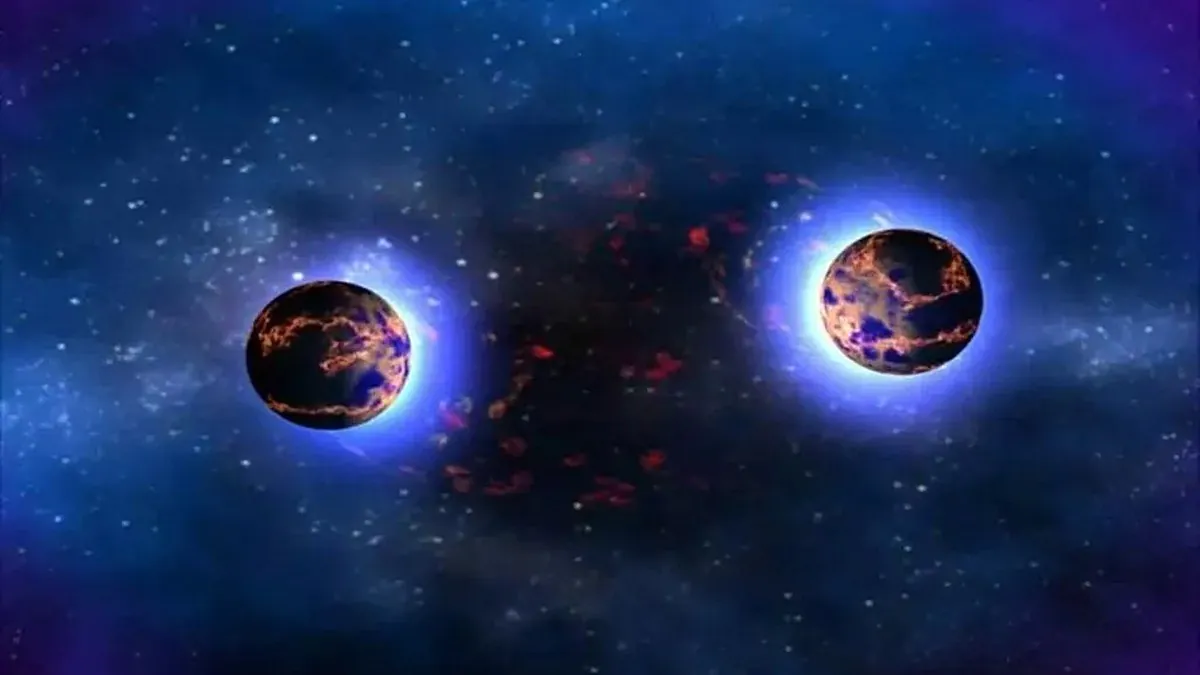
Researchers have found a new way to detect some of the most catastrophic merger events in the universe before they occur – the mergers of neutron stars.
Neutron stars, the extremely dense cores of massive dead stars spiraling toward each other or into a black hole, can raise tidal waves in oceans of heavy charged particles surrounding neutron stars. The researchers found that these tidal waves are caused by regular flashes of electromagnetic radiation, which can serve as an early warning system for impending mergers.
Neutron stars are probably the most extreme objects in the universe. Yes, black holes may be more exotic, but they are relatively simple – they just have a lot of gravity. On the contrary, neutron stars are, in fact, giant atomic cores, and this is due to the interesting and complex physics that black holes do not have.
A typical neutron star is only a few kilometers in diameter, but can weigh several times the mass of the Sun. They consist almost entirely of neutrons (hence the name), but contain populations of free electrons, protons and ions of heavy nuclei. They are born from supernovas – explosions of dying massive stars – and some of them may contain the strongest magnetic fields in the universe.
The interiors of neutron stars are the most mysterious, because the pressure and density are so great that they go beyond our current knowledge of physics. Some models suggest that the cores are simply a homogeneous stream of neutrons, while others suggest that the neutrons themselves decay into their quarks. Behind the inner core there is a solid, smooth mass of neutrons that slowly transitions into more complex patterns, such as lumps and strands, commonly known as nuclear pasta.
It is believed that the outer crust of a neutron star consists of superfluid electrons and neutrons, which give way to the crystal lattice as they approach the surface. Finally, there is the ocean – a layer of liquid electrons, neutrons and ions at a depth of 10 to 100 m.
The extremely exotic nature of matter in these conditions – you don’t typically find superfluid neutrons – allows neutron stars to be the main candidate for the study of extreme physics. This idea was refined after the discovery of GW 170817, a gravitational wave signal detected along with the electromagnetic radiation of two merging neutron stars. The joint discovery, called multisensor astronomy, allows physicists to study the cores of neutron stars like never before.
But since the first gravitational waves were first detected in 2017, we have not seen any other neutron star fusion events, which is disappointing because neutron stars are one of the best natural laboratories for testing high-energy physics.
But now a new method of observing the exotic behavior of neutron stars may mean that we do not have to wait long. A new work, published in May in the arXiv preprint database, focuses on the oceans of neutron stars, which, in addition to free electrons and neutrons, may also contain carbon, oxygen and iron. Although the oceans are relatively shallow compared to the entire depth of a neutron star, they are the outer layer (excluding the incredibly thin “atmosphere”) and the part of the neutron star that responds most easily to the outer universe.
In particular, researchers have found that these shallow oceans can support tides, just like the oceans on Earth. But raising the tide on a neutron star requires much more gravitational pull to overcome all this extreme gravity. Tides on neutron stars appear only when a neutron star is close enough to a massive, dense object, such as another neutron star or black hole.
Fortunately, such binary pairs are relatively common, as stars typically form in several systems and then go through their life cycle, eventually leaving behind combinations of black holes and neutron stars.
When a neutron star begins to merge with another neutron star or black hole, objects slowly converge in a spiral over several years. As they rotate, gravitational waves take energy from the system, pulling them closer. In the end, the merger is completed in seconds.
But before that happens, an orbital satellite could cause a series of resonant tides on a neutron star. These tides can maintain a frequency of up to 100 MHz and carry up to a whopping 10^29 joules of energy. To give you an idea of how large this number is, I will say that every year all mankind uses only 10^20 joules. The resonant wave of a single neutron star has more energy than all the Sun’s radiation in 10,000 years.
Unlike ocean waves, these tides consist of an ocean of plasma. Extraordinary electric charges mean that the tides can emit intense flashes of electromagnetic radiation, which may seem to us to be flashes of X-rays and gamma radiation.
Based on their calculations, the researchers estimated that space observatories such as the Fermi space gamma-ray telescope and the Nuclear Spectroscopic Telescope Array (NuSTAR) could detect several neutron stars each year, and that these signals would appear up to a few years before final fusion.
With this warning, astronomers can prepare their telescopes and observatories to be ready to capture the moment of the merger and delve into even more valuable data on electromagnetic and gravitational waves.
You can also help Ukraine fight with Russian occupants via Savelife or via an official page of the National Bank of Ukraine.
Read also:
Leave a Reply